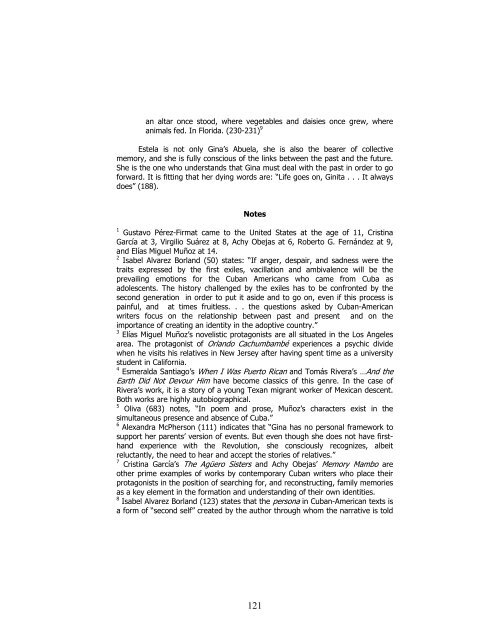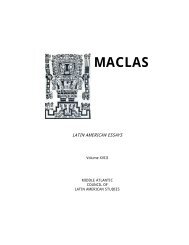latin american essays maclas
latin american essays maclas
latin american essays maclas
You also want an ePaper? Increase the reach of your titles
YUMPU automatically turns print PDFs into web optimized ePapers that Google loves.
an altar once stood, where vegetables and daisies once grew, where<br />
animals fed. In Florida. (230-231) 9<br />
Estela is not only Gina’s Abuela, she is also the bearer of collective<br />
memory, and she is fully conscious of the links between the past and the future.<br />
She is the one who understands that Gina must deal with the past in order to go<br />
forward. It is fitting that her dying words are: “Life goes on, Ginita . . . It always<br />
does” (188).<br />
Notes<br />
1 Gustavo Pérez-Firmat came to the United States at the age of 11, Cristina<br />
García at 3, Virgilio Suárez at 8, Achy Obejas at 6, Roberto G. Fernández at 9,<br />
and Elías Miguel Muñoz at 14.<br />
2 Isabel Alvarez Borland (50) states: “If anger, despair, and sadness were the<br />
traits expressed by the first exiles, vacillation and ambivalence will be the<br />
prevailing emotions for the Cuban Americans who came from Cuba as<br />
adolescents. The history challenged by the exiles has to be confronted by the<br />
second generation in order to put it aside and to go on, even if this process is<br />
painful, and at times fruitless. . . the questions asked by Cuban-American<br />
writers focus on the relationship between past and present and on the<br />
importance of creating an identity in the adoptive country.”<br />
3 Elías Miguel Muñoz’s novelistic protagonists are all situated in the Los Angeles<br />
area. The protagonist of Orlando Cachumbambé experiences a psychic divide<br />
when he visits his relatives in New Jersey after having spent time as a university<br />
student in California.<br />
4 Esmeralda Santiago’s When I Was Puerto Rican and Tomás Rivera’s …And the<br />
Earth Did Not Devour Him have become classics of this genre. In the case of<br />
Rivera’s work, it is a story of a young Texan migrant worker of Mexican descent.<br />
Both works are highly autobiographical.<br />
5 Oliva (683) notes, “In poem and prose, Muñoz’s characters exist in the<br />
simultaneous presence and absence of Cuba.”<br />
6 Alexandra McPherson (111) indicates that “Gina has no personal framework to<br />
support her parents’ version of events. But even though she does not have firsthand<br />
experience with the Revolution, she consciously recognizes, albeit<br />
reluctantly, the need to hear and accept the stories of relatives.”<br />
7 Cristina García’s The Agüero Sisters and Achy Obejas’ Memory Mambo are<br />
other prime examples of works by contemporary Cuban writers who place their<br />
protagonists in the position of searching for, and reconstructing, family memories<br />
as a key element in the formation and understanding of their own identities.<br />
8 Isabel Alvarez Borland (123) states that the persona in Cuban-American texts is<br />
a form of “second self” created by the author through whom the narrative is told<br />
121




